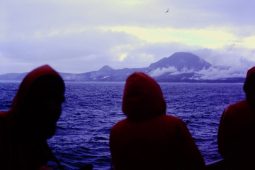Nuclear waste disposal: Geology must come first
For the UK to make meaningful progress on a geological disposal facility for nuclear waste, argues Jonathan Turner, the government must adopt a bold new strategy – one that prioritises geology

Earlier this year, Theddlethorpe in east Lincolnshire withdrew from the siting process for a geological disposal facility despite it having what looked to be the most promising geology of all the areas under consideration. (Image credit: Saltfleet-Theddlethorpe Dunes, National Nature reserve by Chris, CC BY-SA 2.0, via Wikimedia Commons.)
It is time for the UK government to abandon the policy in which voluntary community consent is the primary driver determining the selection of a site for geological disposal of its nuclear waste.
A geological disposal facility (GDF) is a critical item of national infrastructure for dealing permanently with the enduring hazard of the higher activity nuclear waste stockpile that has accumulated over the last 70 or so years, mainly as a byproduct of nuclear power generation. With the decline of fossil fuels, a GDF is also essential to facilitate the transition to cleaner forms of energy including large (e.g., Hinkley Point C in Somerset, Sizewell C in Suffolk) and small-modular nuclear reactors.
Progress stalled
The programme for identifying a suitable site for the waste has been ongoing for some 40 years with no site yet moving forward into borehole drilling and comprehensive site characterization (Turner et al., 2023). Nuclear Waste Services (NWS), the government body tasked with leading the search for a GDF site, has worked tirelessly to engage with any and all communities interested in finding out about what a GDF is and the benefits it would bring in terms of long-term investment in local jobs and infrastructure.
Earlier this year one of the three communities working with NWS – Theddlethorpe in east Lincolnshire – withdrew itself from the siting programme. This removes the possibility of siting a GDF in what looked to be by far the most promising geology under consideration: the Middle Jurassic Ancholme Group, which includes the Oxford Clay Formation (OCF). Note that French and Swiss GDFs will also be constructed in Lower-Middle Jurassic mudstones with similar characteristics to the OCF. Using the criteria published by Nagra (Nagra, 2022), the Swiss waste management organization, the OCF looks to be at least as good as the renowned Aalenian Opalinuston Formation claystone in which their GDF will be constructed at Nӧrdlich Lägern.
The programme for identifying a suitable site has been ongoing for some 40 years
This leaves Mid and South Copeland in Southwest Cumbria as the two communities remaining in the siting programme. The highly fractured Paleozoic rocks along the Cumbrian coastal fringe (that is, outwith the off-limits Lake District National Park) are not an option after a drilling campaign in the 1990s demonstrated the near impossibility of adequately characterizing them (Knipe, 1996). The focus is therefore on investigating the Mercia Mudstone Group (MMG), at least 10 km offshore beneath the Irish Sea. Whilst the MMG could contain sufficiently thick and persistent mudstone (or possibly salt) intervals it is notoriously heterolithic (variable) both vertically and laterally on scales of centimetres to kilometres, thus very challenging to characterise to the required fidelity. An offshore GDF would also be significantly more expensive to construct. It is perhaps significant that some three years after NWS acquired bespoke 3D seismic data offshore from the two Copeland communities there has been no word from NWS on what was found there in terms of geological suitability for a GDF.
Alternative approach
So, what should we do differently? After several decades trying, NWS and its predecessors have demonstrated that a policy of voluntary community consent may never deliver a GDF. An alternative siting policy for the UK is provided by examples from the other national waste management organizations currently progressing their GDF siting programmes (such as, Finland, https://www.posiva.fi/en/; Sweden, https://skb.com/; Switzerland, https://nagra.ch/; France, https://international.andra.fr/; Canada, https://www.nwmo.ca/). All of these have now announced the sites at which they will construct their GDFs yet none were based on an initial voluntary process. Rather, they started their siting programmes by identifying search areas where the geology looked to be suitable (in terms of operational and long-term post-closure safety, and engineering feasibility) and only then began the process of engaging with the various communities. A similar approach has been adopted in Germany (https://www.bge.de/en/), which has effectively re-started its GDF siting process from scratch.
To move forward this knotty problem of identifying candidate GDF locations in the UK, a bold new strategy is needed that promotes the critical role of geology as a primary driver of the siting process. Furthermore, there is a growing imperative to deliver a GDF sooner rather than later: an underpinning principle of higher-activity nuclear waste disposal programmes is intergenerational equity – the generations that benefited from nuclear technologies (i.e. ours, and perhaps the next couple) should be the ones to get the ball rolling on disposing of the waste, and indeed, funding its disposal.
Jonathan Turner CGeol FGS
Former Chief Geologist, Nuclear Waste Services
https://www.jonathanturner.co.uk/nuclear-waste
Further reading
- Knipe, C. (1996) Appendix 1 to Inspector’s Report. C.S. McDonald (Ed.), Report on the Public Enquiry Appeal by United Kingdom Nirex Limited, Ref APP/ H0900/A/94/247019
- Nagra (2022) Why Nördlich Lägern? The 13 site selection criteria; https://nagra.ch/en/why-nordlich-lagern-the-13-site-selection-criteria/
- Turner, J.P. et al. (2023) Role of the geosphere in deep nuclear waste disposal–An England and Wales perspective. Earth-Science Reviews 242, 104445; https://doi.org/10.1016/j.earscirev.2023.104445
- UK Government (2025) Lincolnshire County Council withdraws from the GDF siting process. Nuclear Waste Services, 3 June; https://www.gov.uk/government/news/lincolnshire-county-council-withdraws-from-the-gdf-siting-process
Citation: Turner, A. Nuclear waste disposal: Geology must come first. Geoscientist 35 (3), 18-19, 2025. DOI: 10.1144/geosci2025-020.










